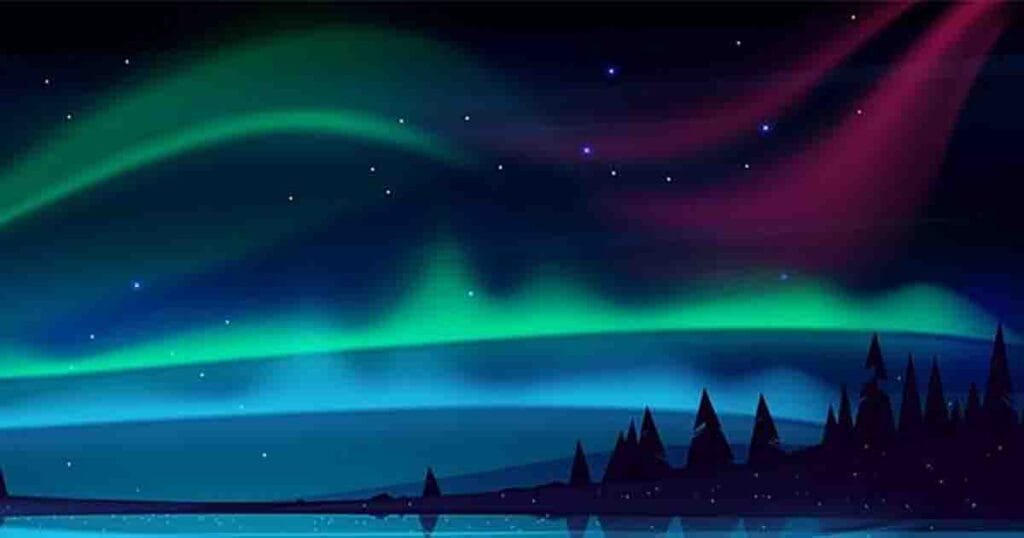- 2024 solar activity expanded Aurora Borealis visibility beyond Arctic regions.
- A historic G5 geomagnetic storm brought auroras to the UK and USA.
- Solar cycle impacts auroras, with increased frequency during high solar activity.
- Geomagnetic storms disrupt Earth’s magnetic field, affecting technology.
- Astrotourism grows as people travel to view the stunning auroral displays.
In 2024, the Aurora Borealis, or Northern Lights, made an extraordinary appearance beyond its usual Arctic boundaries. Millions across the Northern Hemisphere marveled at this rare event. It was caused by heightened solar activity and powerful geomagnetic storms. These storms expanded the auroral oval to regions unaccustomed to this celestial show.
The Aurora Borealis occurs when charged particles from the Sun collide with Earth’s magnetic field. Solar winds carry these particles, which interact with atmospheric gases like oxygen and nitrogen. These collisions create vibrant light displays in colors such as green, red, purple, and blue. The specific color depends on the gas type and the altitude of the interaction.
The phenomenon intensifies during the Sun’s 11-year solar cycle. In May 2024, a G5-level geomagnetic storm amplified the auroras. This made them visible in unexpected locations.
A Historic Solar Storm Expands the Aurora’s Reach
In May 2024, a G5 geomagnetic storm produced breathtaking auroras far beyond the Arctic. The Northern Lights were visible in the United Kingdom, including Scotland, Northern Ireland, and northern England. Social media buzzed with stunning images and videos. These posts sparked global excitement.
In Germany’s Baltic Sea region near Kiel, the Northern Lights appeared for the first time in recorded history. Residents and astronomers were amazed by this rare event. The vivid auroras contrasted beautifully with the serene Baltic coastlines. This created an unforgettable experience.
In the United States, states like Michigan, Minnesota, and parts of the Pacific Northwest enjoyed rare views of the Northern Lights. These states are usually too far south for auroras. These events highlight the increasing solar activity as the Sun approaches its solar maximum in 2025.
Understanding the Solar Cycle and Its Effects
The Sun’s 11-year solar cycle plays a crucial role in auroral activity. During high solar activity, solar flares and coronal mass ejections (CMEs) disrupt Earth’s magnetic field. This disruption causes geomagnetic storms. These storms usually generate auroras near the poles.
As the solar cycle peaks, these displays occur more frequently and at lower latitudes. Advanced observatories like NASA’s Solar Dynamics Observatory (SDO) and the European Space Agency’s Solar and Heliospheric Observatory (SOHO) monitor solar activity in real time. This data helps scientists predict geomagnetic storms and their impacts.
These forecasts prepare regions for rare auroral displays. They also enhance public awareness. Geomagnetic storms are rated from G1 to G5, with G5 being the most intense. While visually stunning, these storms can disrupt satellite communications, GPS systems, and power grids.
Scientific Insights and Technological Challenges
The 2024 auroras have provided valuable data on solar winds and Earth’s magnetic field. Scientists aim to refine space weather predictions. They also work to improve infrastructure resilience against solar storms. These storms can interfere with satellite electronics. They can also cause power grid fluctuations.
Engineers are developing stronger defenses for satellites and power grids. Enhanced forecasting techniques, informed by observatory data, are crucial. These techniques help minimize disruptions during solar storms.
Astrotourism: A Growing Global Trend
The Aurora Borealis’s increased visibility has fueled global interest in space science and astronomy. This fascination has led to a surge in astrotourism. Travelers are flocking to regions where auroras are expected. Organizations like NOAA’s Space Weather Prediction Center provide reliable forecasts. These forecasts enable enthusiasts to plan trips and witness these awe-inspiring displays.
A Bright Future for Celestial Wonders
As the solar cycle peaks, geomagnetic storms will likely become more frequent and intense. This creates more opportunities for auroral displays beyond the Arctic. These events not only captivate audiences but also advance our understanding of the Sun’s impact on Earth.
The Aurora Borealis symbolizes the dynamic interplay between our planet and the cosmos. It inspires wonder and discovery.
In conclusion, the rare auroral displays of 2024 highlight the connection between solar activity and Earth’s magnetic field. These events provide breathtaking experiences. They also emphasize the need to prepare for space weather challenges. As we look to the skies, the Aurora Borealis remains a testament to nature’s beauty and humanity’s curiosity.


